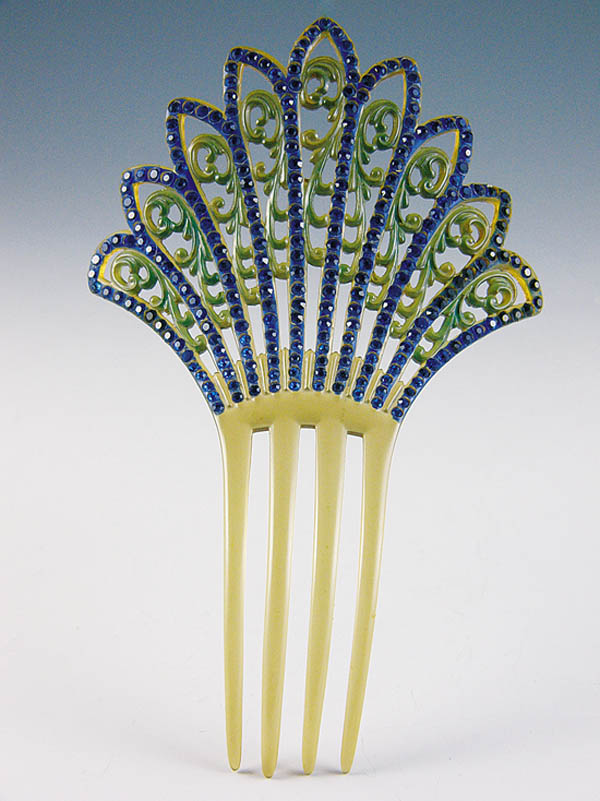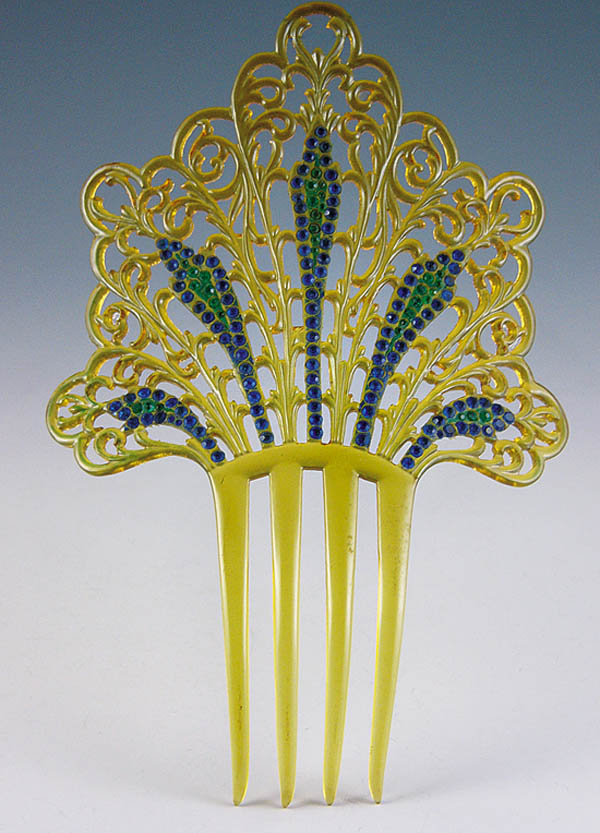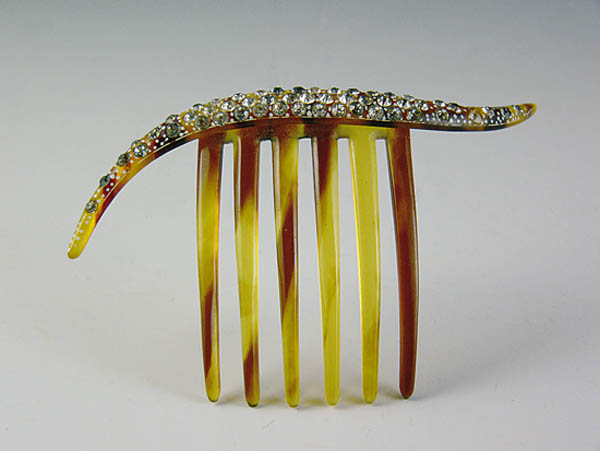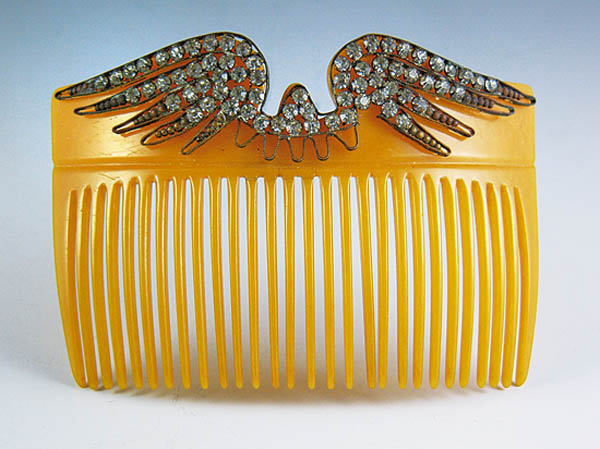Crowning Glories: Decorative Hair Combs
Smack Dab In The Middle: Design Trends Of The Mid-20th Century
By Donald-Brian Johnson - March 12, 2021
Gimme a head with hairlong beautiful hair! Shining, gleaming, steaming, flaxen, waxen! Hair (Rado, Ragni, & MacDermot, 1967) Of course, something had to keep that long beautiful hair from flying all over the place. In the days before bobby pins and barrettes, that something was the decorative hair comb. Wilma Flintstone probably used one, since boxwood combs have been unearthed dating to the Stone Age. In Wilmas day, popular choices for combs were wood, ivory, and fish bones (like the one used to skewer that top knot on little Pebbles). Although Wilma might not like it mentioned, the earliest combs served a practical purpose: removing dirt, insects, and other unsavory objects. The hair comb seems to have developed independently in different cultures around the globe. And, with its curved shape and multiple teeth, its easy to deduce the combs inspiration: that somewhat grubbier predecessor, the human hand. Until the 1800s, hair combs were made of natural materials. Among the most popular: tortoiseshell, horn, jet, coral, ivory, and precious metals. Celluloid made its debut in the 1860s, mimicking the look of tortoiseshell and ivory at a fraction of the cost. The only drawback: flammability. A celluloid-comb-wearing fashion plate leaning too close to a bright candle might find her combs (and probably her hair) going up in smoke. In France during the 1700s, towering, powdered hairstyles were held in place with jeweled combs. Since these confections were so elaborate, the dos often stayed in place for months between washings. All that white powder kept the (ahem) bugs at bay. During the Victorian era, decorative combs came in handy for pinioning into place the false hair needed to achieve the illusion of abundant tresses. By the mid-1800s, the rise of mass manufacturing meant that attractive comb sets, often adorned with paste jewels, were within the reach of almost every pocketbook. Large, straight combs, many in graceful fan shapes, were the centerpiece, accompanied by smaller side and curved back combs. In the hair comb litany, four teeth or more made a comb a comb. Three teeth qualified as a hair ornament, while two marked it as a hair pin. Sizes ranged from 5.5 to 10.5 inches. And then, along came Irene Castle. In 1919, the famed dancer bobbed (i.e., hacked off) her lustrous locks, and the world flipped its wig. Soon, bobbed hair was the bees knees. What was a poor hair comb to do? Easy: adapt. During the decades since, hair combs have primarily focused on decorative appeal. In the 1920s, oversize Victorian mantilla combs made a return appearance, precariously wedged into slicked-back bobs. In the 1930s, smaller combs in abstract geometric shapes were an Art Deco highlight. Piles of flamboyantly arranged curls were a staple during the 40s, and equally flamboyant combs kept them from toppling. In the 1950s, hair combs were a glittering evening wear accompaniment, while the bouffant hairdos of the 60s made combs a must. Seeds, beads and other miscellaneous dangles decorated combs of the free-spirited 1970s, and the big hair of the 1980s Dynasty years meant that no hair comb could be too big (or too gaudy). Few combs were signed, although there were exceptions: Auguste Bonaz, Miriam Haskell, and Ren Lalique have each created signed combs. As hairstyles have continued to evolve, so have hair combs. Nowadays, it may be a claw or a banana clip, but one things for certain: if its in the hair, its some variation of a comb. And, thanks to the introduction of plastic in the 1930s, there are now endless choices of colors and patterns to comb through. Collecting combs is a hobby with teeth in it. Rarely are two designs alike, and prices are hardly hair-raising: a $25 starting point for celluloid combs, ranging up to $125 or more for signed combs and combs of precious metals or ivory. At those prices, even Wilma Flintstone wont be tearing her hair out. Hair combs courtesy of Maureen Maher. Photo Associate: Hank Kuhlmann. All photos by Donald-Brian Johnson. Donald-Brian Johnson is the co-author of numerous books on design and collectibles, including Postwar Pop, a collection of his columns. He carries a pocket comb. Please address inquiries to: donaldbrian@msn.com.










SHARE
PRINT